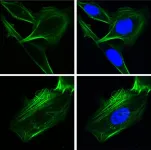(Press-News.org)
A surprising finding from USC reveals key details about how cancer cells metastasize and suggests new therapeutic approaches for halting their spread.
The research, supported by the National Institutes of Health, centers on a cellular chaperone protein known as GRP78, which helps regulate the folding of other proteins inside cells. Previous studies from the same team, led by Amy S. Lee, PhD, professor of biochemistry and molecular medicine at the Keck School of Medicine of USC, have shown that when cells are under stress (due to COVID-19 or cancer), GRP78 gets hijacked, allowing viral invaders to replicate, and cancers to grow and resist treatment.
Lee and her colleagues have now made an unexpected discovery that may eventually enable scientists to protect cells from that hostile takeover. Typically, GRP78 resides in a part of the cell called the endoplasmic reticulum. But when cells are under stress, the chaperone protein migrates to the cell’s nucleus, where it alters gene activities and changes the behavior of the cell, allowing the cancer cells to become more mobile and invasive.
“Seeing GRP78 in the nucleus controlling gene expression is a total surprise,” said Lee, the study’s senior author and the Judy and Larry Freeman Chair in Basic Science research at the USC Norris Comprehensive Cancer Center. “When it comes to the basic mechanisms of cancer cells, this is something novel that, to my knowledge, no one has observed before.”
The findings, just published in the Proceedings of the National Academy of Sciences, could represent a paradigm shift for cell biology, and have implications for cancer therapeutics research, Lee said.
An unanticipated discovery
The new discovery started as an incidental one. Ze Liu, PhD, a postdoctoral researcher in Lee’s lab and the study’s first author, was analyzing how GRP78 regulates a gene known as EGFR, long linked to cancer. He noticed something surprising: GRP78 controls the gene activity of EGFR, raising the intriguing possibility that GRP78 may have entered the nucleus and assumed a new role. But the chaperone protein was long thought to exist primarily in the endoplasmic reticulum of cells.
To confirm their hypothesis, Liu, Lee and their colleagues used confocal microscopy, which offers high-resolution 2D and 3D imaging, coupled with an advanced technique for capturing images of live cells, to directly observe GRP78 in the nucleus of lung cancer cells, as well as normal cells under stress. They then used several other techniques, including biochemical analysis and mRNA “knock-down” of GRP78. These techniques allowed them to identify the signal within GRP78 that enables it to enter the nucleus and confirm that when GRP78 is present in the nucleus, it stimulates EGFR gene activity.
Next, the researchers set out to learn more about what happens in a cell after GRP78 enters the nucleus. Using a sophisticated form of RNA sequencing they compared lung cancer cells engineered to over-express GRP78 in the nucleus to cells lacking GRP78 in the nucleus in order to learn which genes were affected.
“To our big surprise, we found that the key genes being regulated by GRP78 in the nucleus are mainly involved with cell migration and invasion,” Lee said.
The team found that GRP78 binds to ID2, another cellular protein. ID2 typically suppresses genes (including EGFR), many of which allow cells to migrate. But when bound to GRP78, ID2 can no longer do its job. Without that suppression, cancer cells become more invasive.
Broad implications for cancer and cell biology
The new findings point to several potential new approaches for cancer treatment, including down-regulating the activity GPR78 to suppress EGFR in lung cancer, or preventing it from binding to ID2. GRP78 could also bind to other proteins in the nucleus critical for cancer, opening up a new line of research in cancer biology. While the present study analyzed lung cancer cells, GRP78 plays a similar role in various types of cancers, including pancreatic, breast and colon cancer.
The discovery that GRP78, a major endoplasmic reticulum protein, can travel to the nucleus and assume new functions, could also have broad implications across the field of cell biology. Lee said it’s possible—even likely—that other proteins that typically reside in one part of the cell could, under stress or other triggers, migrate to another part of the cell and alter cell behavior in multiple ways.
“This is a new concept,” she said. “The protein itself is the soldier that does the job, but now we’re thinking it’s not just about the soldier, but also where the solider is deployed.”
Lee and her team are also studying drugs that can inhibit the expression or activity of GRP78. An ongoing study of theirs suggests that small molecules that inhibit GRP78, such as YUM70, may even be able to block GRP78 activity in the nucleus of cells.
About this study
In addition to Lee and Liu, the study's other authors are Guanlin Liu and Dat P. Ha from the Department of Biochemistry and Molecular Medicine, Keck School of Medicine of USC; Justin Wang from the Department of Molecular Medicine, Scripps Research; and Min Xiong from the Department of Systems Biology, Beckman Research Institute, City of Hope.
This work was supported by the National Institutes of Health [R01 CA027607, CA238029].
Disclosure: Lee is an advisory board member of BiPER Therapeutics, a biotechnology company that develops cancer treatment drugs.
END
The study by Maarten van Herpen et al., entitled “Photocatalytic Chlorine Atom Production on Mineral Dust-Sea Spray Aerosols over North Atlantic,” was funded in part by the NGO Spark Climate Solutions. It incorporates a proposed new mechanism whereby blowing mineral dust mixes with sea-spray to form Mineral Dust-Sea Spray Aerosol (MDSA).
The results suggest that MDSA is activated by sunlight to produce an abundance of chlorine atoms, which oxidize atmospheric methane and tropospheric ozone via photocatalysis. Largely composed of blowing dust from the Sahara Desert combined with sea salt aerosol from the ocean, MDSA is the dominant source of atmospheric ...
Researchers from the University of Florida and the Seattle Aquarium are exploring 100 meters underwater in the Pacific Northwest this summer to learn more about mysterious ghost sharks, one of the strangest beasts from the depths of the ocean.
Using remotely operated underwater vehicles, or ROVs, the scientists searched for nesting grounds of the Pacific spotted ratfish, Hydrolagus colliei, a ghostlike fish that lurks on the ocean floor.
“We know very little about these elusive relatives of sharks and even less about their spawning habits and embryonic development,” said ...
Research Highlights:
An analysis of more than 202,000 heart attack deaths between 2015-2020 in a single Chinese province found that days that had extreme heat, extreme cold or high levels of fine particulate matter (PM2.5) air pollution were significantly associated with the risk of death from a heart attack, especially in women and older adults.
The greatest increase in the risk of death from heart attack was seen on days that had the combination of extreme heat and high levels of PM2.5.
The days with extreme heat were associated ...
Based on findings from a study published today in the journal, The Lancet Regional Health – Americas, researchers at Johns Hopkins Medicine and three collaborating medical institutions suggest that people living with the human immunodeficiency virus (HIV) who donate a kidney to other people living with HIV (PLWH) have a low risk of developing end-stage kidney disease (ESKD) or other kidney problems in the years following the donation.
“This new evidence is proof-of-concept that donating a kidney can be safe for people living with HIV,” says Christine Durand, M.D., associate professor of medicine at Johns ...
Water is essential for life as we know it. However, scientists debate how it reached the Earth and whether the same processes could seed rocky exoplanets orbiting distant stars. New insights may come from the planetary system PDS 70, located 370 light-years away. The star hosts both an inner disk and outer disk of gas and dust, separated by a 5 billion-mile-wide (8 billion kilometer) gap, and within that gap are two known gas-giant planets.
New measurements by NASA’s James Webb Space Telescope’s MIRI (Mid-Infrared Instrument) have detected water vapor in the system’s inner disk, at distances ...
Ann & Robert H. Lurie Children’s Hospital of Chicago is leading an awareness campaign that aims to reduce missed or delayed diagnosis of cystic fibrosis after newborn screening, especially in non-White infants. In its first phase, the campaign targets primary care providers and public health officials, so that treatment can start earlier, which is linked to better outcomes for people with cystic fibrosis. The general public phase is expected to follow within the year.
Funded by the Centers for Disease Control and Prevention ...
A potent anti-cancer therapy has been created using Nobel prize-winning “click chemistry”, where molecules click together like LEGO bricks, in a new study by UCL and Stanford University researchers.
The study, published in Nature Chemistry, opens up new possibilities for how cutting-edge cancer immunotherapies might be built in future.
The research team created an anti-cancer therapy with three components: one targeting the cancer cell, another recruiting a white blood cell called a T cell to attack the cancer cell, and a third knocking out part of the cancer cell’s defences.
Previously, ...
New York, NY – The American Federation for Aging Research (AFAR), a national non-profit organization whose mission is to support and advance healthy aging through biomedical research, is proud to recognize the outstanding contributions of Claire K. Ankuda, MD, MPH, MSc with the 2023 Terrie Fox Wetle Rising Star Award in Health Services and Aging Research.
This award honors a health services researcher in an early or middle phase of his/her career who has already made important contributions with work that respects the value of multidisciplinary health services ...
New York, NY – The American Federation for Aging Research (AFAR), a national non-profit organization whose mission is to support and advance healthy aging through biomedical research, is pleased to recognize the exemplary contributions of Ming Xu, PhD, to the field of aging research through the 2023 Vincent Cristofalo Rising Star Award in Aging Research.
This award is named in honor of the late Dr. Cristofalo, who dedicated his career to aging research and to encouraging young scientists to investigate important problems in the biology of aging. Established in 2008, the award is a ...
The American Federation for Aging Research (AFAR), a national non-profit organization whose mission is to support and advance healthy aging through biomedical research, is pleased to recognize the exemplary contributions of Rafael de Cabo, PhD, to the field of aging research through the 2023 Irving S. Wright Award of Distinction.
This award is named in honor of AFAR’s founder and recognizes exceptional contributions to basic or clinical research in the field of aging. Established in 1982, the award is a framed citation and carries a cash prize of $5,000.
Dr. de Cabo is Senior Investigator of the ...









